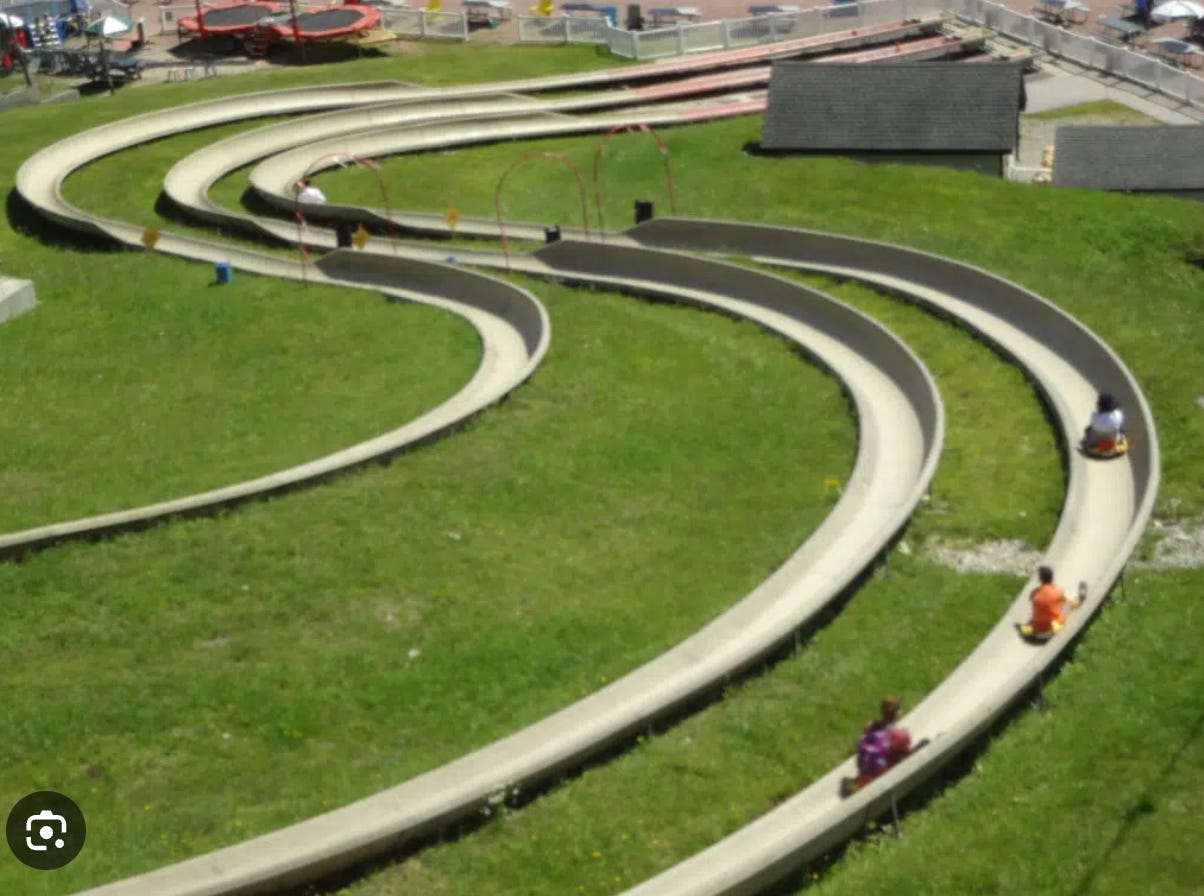The Rise and Fall of Vermont’s Alpine Slides, Anecdotes and All
A Vermont Reddit member asked, "What ever happened to the alpine slide? Plenty of short stories, and this article, came out of it.
A Summer Invention That Changed Vermont Ski Hills
Bromley Mountain lit the spark in 1976, installing what resort historians describe as the first triple-tracked alpine slide in North America. According to Bromley’s history and ski industry accounts, the ride was inspired by German engineering and built in partnership with Demag Corporation of West Germany using fiberglass tracks.
The response from the public was immediate. According to Stig Albertsson, who was involved in its creation, opening weekend saw lines stretching three and a half hours long. Families and thrill-seekers flocked to experience something entirely new: the ability to ride a sled down the mountainside in the warmth of summer.
“Loved the Bromley Alpine slide. Got such a gash on my leg when I was screwing around and fell off the sled. The track had no mercy.” - Reddit post.
Vermont’s Three Slides: Bromley, Pico, and Stowe
Bromley Mountain (Peru): Bromley’s slide is still operating and remains a signature of the resort’s summer park. According to the resort and regional press, its three fiberglass tracks run nearly two-thirds of a mile with an 850-foot drop, making it one of the longest slides of its kind.
Pico Mountain (Killington): Pico installed twin fiberglass slides in 1981 after securing approval from the town and selecting a supplier. According to archived Rutland Daily Herald reports and ride histories, the slides stretched about 3,650 feet. They last ran in the summer of 2011 and did not return.
Stowe Mountain Resort (Spruce Peak): Stowe also operated a dual alpine slide for roughly 25 years. According to ski history records, the slides closed after the 2013 season when the resort reconfigured its beginner terrain and lift system.
Today, Bromley is the only alpine slide still operating in Vermont, according to Addison County reporting and resort materials.
“I had the exact same experience at Pico as a kid. My whole forearm was absolutely torn apart with road rash, and the gauze they use became one with my arm. It was the absolute worst! I think I kept riding it though...” - Reddit post.
Archival Snapshots and “Where Were You When” Memories
“Selected by Pico” (1981): When Pico green-lit its slide, the Rutland Daily Herald published an article announcing that the resort had chosen a supplier, describing the scope of the project. For many locals, that news marked the start of a new summer tradition at the hill.
Opening-Day Crush at Bromley (1976–77): Longtime staff recall those first summers for the sheer size of the crowds—multi-hour waits and bumper-to-bumper traffic on the access road—according to Bromley’s anniversary accounts and interviews with its creators.
Pico’s Abrupt Finale (2011): Tropical Storm Irene devastated parts of central Vermont in late August 2011. In the days after the storm, Killington officials announced that Pico’s summer operations, including the alpine slide, would not reopen that year. According to contemporaneous reports, that announcement became the de-facto end note for Pico’s slide.
Stowe’s Last Run (2013): Stowe’s slide ended more quietly. After about 25 years, it closed following the 2013 off-season as the resort reworked its facilities at Spruce Peak. According to local recollections, many still remember the ride’s thrill and occasional scrapes.
“It was like the simpsons water slide, but it wasn’t funny at the time. I got yelled at by the ride attendant at the bottom as well for not braking even though I did. I tried to argue but then my parents got mad at me for talking back to an adult and we left and I got punished. I now have another issue to discuss with my therapist tonight, thanks!”
Why the Slides Faded
Alpine slides declined for several reasons. According to New England Ski History, safety was an ongoing concern, since riders controlled their own sleds and speed. Maintenance and staffing needs added to costs, particularly for seasonal operations.
At the same time, resorts began investing in mountain coasters, zip lines, and adventure parks. According to industry reports, coasters offered year-round operation, smoother rides, and more consistent safety standards, making them more attractive to both insurers and families.
“I hit the middle turn and tumbled over, got some pretty serious road rash from scraping along the tube. Had to right it before somebody else ran me over.”
What Survives—and Why It Matters to Vermonters
Bromley kept the tradition alive. According to the resort, its alpine slide has now operated for nearly five decades and remains the centerpiece of its Mountain Adventure Park, which includes climbing walls, water features, and other family attractions.
“2-inch scar on my thigh. Those carts were so heavy and burned my hands. I loved it.”
For many families, the ritual looks familiar: ride the lift with a sled, lean into the turns, and hear children’s laughter echo down the slope. That is the nostalgia—earned over decades—that keeps Bromley’s slide moving. According to longtime visitors and regional coverage, Bromley’s enduring ride ensures that a piece of Vermont’s summer history is still alive.



